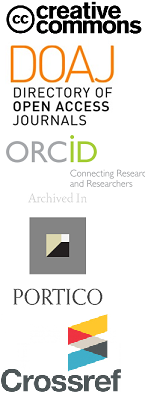Les modèles de métaphores dans la fiction sésotho : Le cas du roman Chaka
DOI :
https://doi.org/10.17159/tl.v61i2.15821Mots-clés :
Chaka, continuité, discontinuité, fiction, littérature, métaphoreRésumé
Cette étude analyse les métaphores dans le roman sesotho Chaka de Thomas Mofolo. Nous répertorions et analysons les métaphores conceptuelles et linguistiques pour voir si elles sont conventionnelles ou nouvelles, créatives ou non, et leur distribution entre les classes de mots. La plupart des métaphores sont conventionnelles et visent à rendre le texte compréhensible pour les Basothos du début du 20e siècle. Nous observons également des influences culturelles et cognitives du Sesotho, ainsi que des intentions de création littéraire similaire aux textes occidentaux et de promotion du christianisme. Ces liens avec la culture sésotho ont retardé la publication du roman.
Téléchargements
Références
Chaka, Limakatso. “Land, botho and identity in Thomas Mofolo’s novels.” Tydskrif vir Letterkunde vol. 53, no. 2, 2016, pp. 63–86. DOI: https://doi.org/10.17159/tvl.v.53i2.5. DOI: https://doi.org/10.17159/tvl.v.53i2.5
Dorst, Aletta. Metaphor in Fiction: Linguistic Forms, Conceptual Structures, and Cognitive Representations. LOT Dissertation Series, 2011.
Franz, Gottfried Heinrich. The Literature of Lesotho. U of Witwatersrand P, 1930. DOI: https://doi.org/10.1080/02561751.1930.9676236
Gill, Stephen. “Thomas Mofolo: The man, the writer and his contexts.” Tydskrif vir Letterkunde vol. 53, no. 2, 2016, pp. 15–38. DOI: https://doi.org/10.17159/tvl.v.53i2.2. DOI: https://doi.org/10.17159/tvl.v.53i2.2
Hermanson, Eric Alfred. Metaphor in Zulu: Problems in the Translation of Biblical Metaphor in the Book of Amos. Sun, 2006. DOI: https://doi.org/10.18820/9781920109288
Kövecses, Zoltan. Metaphor: A Practical Introduction. Oxford U P, 2010.
Krog, Antjie. “oi, oi! … you must go by the right path: Mofolo’s Chaka revisited via the original text.” Tydskrif vir Letterkunde vol. 53, no. 2, 2016, pp. 87–97. DOI: https://doi.org/10.17159/2309-9070/tvl.v.53i2.1466. DOI: https://doi.org/10.17159/2309-9070/tvl.v.53i2.1466
Kunene, Daniel Pule. The Works of Thomas Mofolo: Summaries and Critiques. U of California, 1970.
Lapasau, Merry, et al. “Conceptual metaphors in modern Indonesian literature and their implication in language learning.” Proceedings of the 1st International Conference on Folklore, Language, Education and Exhibition. Atlantis, 2019, pp. 235–40.
Lenake, Johan. “Southern Sotho Literature Part II: The development between 1960 and 1990.” Comparative literature and African literature. Eds. Albert Stanislaus Gerard & Chris Swanepoel. Via Afrika, 1993, pp. 129–54.
Maake, Nhlanhla. “Watermarks in the Sesotho Novels of the Twentieth Century.” Research in African Literatures vol. 37, no. 3, 2006, pp. 65–82. DOI: https://doi.org/10.1353/ral.2006.0070
Mabille, Adolphe & Hermann Dieterlen. Sesuto-English Dictionary. Morija Sesuto Book Depot, 2011.
Makamane, Rets’epile. “Aesthestics of Sesotho Literature: The fiction of Thomas Molo, the novelists who came after him.” Diss. U London, 2023. https://eprints.soas.ac.uk/39624/.
Maledo, Richard & Emmanuel Emama. “Metaphorising the Nigerian Space: A Critical Stylistic Study of Stephen Kekeghe’s Rumbling Sky”. 3L: Language, Linguistics, Literature. The Southeast Asian Journal of English Language Studies vol. 28, no. 4, 2022, pp. 169–83. DOI: http://doi.org/10.17576/3L-2022-2804-12. DOI: https://doi.org/10.17576/3L-2022-2804-12
Mofolo, Thomas. Chaka. Morija Sesuto Book Depot, 1980.
Ononye, Chuka Fred & Innocent Chiluwa. “There’s still something positive about the Niger Delta ecology: Metaphor and ideology in the Niger Delta poetic discourse.” Language and Literature vol. 32, no. 3, 2023, pp. 275–96. DOI: https://doi.org/10.1177/096394702311586. DOI: https://doi.org/10.1177/09639470231158694
Seepheephe, Ntšoeu. “Metaphor Frequency and Distribution in Three Sesotho Newspapers’ Coverage of HIV and AIDS.” Language Matters vol. 52, no. 3, 2021, pp. 94–113. DOI: https://doi.org/10.1080/10228195.2021.1963812. DOI: https://doi.org/10.1080/10228195.2021.1963812
Seepheephe, Ntšoeu & ’Makhetsi Makha-Ntlaloe. “The discourse-based approach towards the translation of metaphors: ‘Journey’, ‘movement’, and ‘body metaphors’ in translation of the Sesotho novel Chaka.” JULACE: Journal of the University of Namibia Language Centre vol. 5, no. 2, 2021, pp. 67–77. DOI: https://doi.org/10.32642/julace.v5i2.1511. DOI: https://doi.org/10.32642/julace.v5i2.1511
Seepheephe, Ntšoeu, Beatrice Ekanjume-Ilongo & Raphael Thuube. “Linguistic Metaphor Identification in Sesotho.” Metaphor Identification in Multiple Languages: MIPVU Around the World, edited by Susan Nacey, et al. John Benjamins, 2019. pp. 268–87. DOI: https://doi.org/10.1075/celcr.22.13see
Steen, Gerald, et al. “Method for Linguistic Metaphor Identification.” Metaphor Identification in Multiple Languages: MIPVU around the World, edited by Susan Nacey, et al. John Benjamins, 2019, pp. 23–40.
Tekateka, Johannes Molupe Mokoena. “A Critical Literary Survey of Thomas Mofolo’s Writings.” Diss. U South Africa, 1967.
Tšiu, William Moruti. “Basotho oral poetry at the beginning of the 21st century.” Diss. U South Africa, 2008. https://uir.unisa.ac.za/handle/10500/1362.
Vassilatos, Alexia. “The Transculturation of Thomas Mofolo’s Chaka.” Diss. U Witwatersrand, 2008.
Zulu, Nkosana. “The literary history of Sesotho literature in social transition: a survey of prominent themes and trends after 1990.” South African Journal of African Languages vol. 23, no. 2, 2003, pp. 77–94. DOI: https://doi.org/10.1080/02572117.2003.10587208. DOI: https://doi.org/10.1080/02572117.2003.10587208
Téléchargements
Publiée
Numéro
Rubrique
Licence
(c) Copyright Tydskrif vir Letterkunde 2024

Ce travail est disponible sous licence Creative Commons Attribution - Partage dans les Mêmes Conditions 4.0 International.


 https://orcid.org/0000-0001-6465-6584
https://orcid.org/0000-0001-6465-6584


.png)